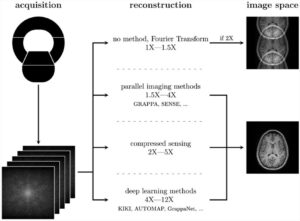Artificial intelligence (AI) shows strong promise in helping to address global challenges faced by healthcare. Through improving patient outcomes or expanding precision medicine, AI offers the opportunity to manage staff shortages and enable cost-effectiveness. According to a study conducted by the management consulting firm PWC, the use of AI helps with early detection of serious diseases and leads to better decision making regarding treatment options. The European healthcare economy could potentially save 170 billion Euros over a ten-year period. This is one of the findings of the “Sherlock in Health” [1] study, which concentrates on three particularly widespread diseases: childhood obesity, dementia, and breast cancer. As an evolutionary influence in healthcare, AI has the potential to act as a digital companion to physician evaluations, improve routine clinical procedures, and advance physicians’ agendas by freeing up practitioners to focus on value-creating work.
AI’s healthcare evolution
Several AI-powered applications are already running in the background, rather silently, greatly empowering healthcare staff in their daily tasks. One such example is AI-powered technologies during medical image acquisition. This enables machine scans to adapt to individual patient characteristics more precisely, resulting in data for more efficient image interpretation. AI solutions must undergo extensive training involving large amounts of curated clinical data and include a super-computing infrastructure that allows for a comprehensive amount of AI experiments per day.
Augmenting human intelligence with digital companions
Imagine an “augmented radiologist” that receives high-quality pre-analyzed and pre-quantified information and can focus on diagnostic decision making. Searching for abnormalities and quantitative evaluation can be supported by digital companions [2] to save time and repletion. An “augmented clinician” makes clinical decisions based on AI-powered suggestions through meaningful, case-specific, and multi-disciplinary integration of relevant patient health data, whilst considering clinical pathway guidelines. These intelligent companions can alert physicians to disease-relevant abnormalities that would have potentially been missed because they were not the focus of the original examination. Thus, sharing work between the doctor and their AI-based companion can lead to more personalized and efficient diagnostics and therapy; in other words, this can lead to precision medicine.
Road to success for AI adoption in clinical routine
Domain know-how and deep understanding of clinical workflows are key to bringing AI into the right context and enabling a holistic solution. Entire areas of problem-solving need to be addressed; not just single tasks. In the case of thoracic CT imaging, for example, an automated reading solution is only beneficial if it covers the full reading spectrum [3]. This offers a holistic evaluation of the scanned body region, including heart, lung, aorta, and vertebral bodies. Today’s healthcare environment will require end-to-end AI-powered solutions with proven productivity gains, according to a recent analysis [4] by healthcare technology consulting firm Signify Research. AI should not reinvent workflows but improve and accelerate what physicians do every day.
Advancing the physician agenda and application in radiology
Specialists may view AI as a technology they have to compete against. However, AI should be seen as an invaluable tool in the specialist’s toolbox. By definition, it’s intended to augment or even emulate human intelligence and decision-making, thus contributing to successful problem-solving. Let’s take radiology as an example: AI-powered automated image interpretation could prove to be an indispensable aid to cope with increasing workloads in radiology. Most experts agree that intelligent algorithms will increasingly find their way into the radiological routine in the coming years. Therefore, a probable scenario is that radiologists will need to adapt their methods and ways of thinking – and to work in a far more interdisciplinary way in their clinical and scientific activities. Thus, AI won’t replace radiologists [5]; it will relieve them of routine tasks, thereby increasing the efficiency and quality of diagnostic imaging processes.
- Sherlock in Health – How artificial intelligence may improve quality and efficiency, whilst reducing healthcare costs in Europe. (n.d.). Retrieved from https://www.pwc-wissen.de/pwc/de/shop/publikationen/Sherlock in Health/?card=23424
- Artificial intelligence. (n.d.). Retrieved from https://www.siemens-healthineers.com/infrastructure-it/artificial-intelligence/ai-rad-companion
- White paper: Assisted Multi-Organ Image Interpretation in the Age of Artificial Intelligence. (n.d.). Retrieved from https://static.healthcare.siemens.com/siemens_hwem-hwem_ssxa_websites-context-root/wcm/idc/groups/public/@global/documents/download/mda4/nzqz/~edisp/siemens-healthineers_ds_artificial-intelligence_white-paper_assisted-multi-organ-05905490.pdf
- Harris, S. (2018, February 28). Will AI in Medical Imaging ‘Cross the Chasm’? Retrieved from https://www.signifyresearch.net/medical-imaging/will-ai-in-medical-imaging-cross-the-chasm/
- Lindner, M. (2018, November 7). The Changing Role of the Radiologist in the Age of AI. Retrieved from https://www.siemens-healthineers.com/news/mso-radiologist-profile.html
Learn more about AI’s growing role in routine care at Siemens Healthineers
http://www.siemens-healthineers.com/ai
Find more insights at:
https://www.siemens-healthineers.com/insights/news?stc=wwhc206050#/?filters=01-AF__IN_DIGITHEALTH_VP4













